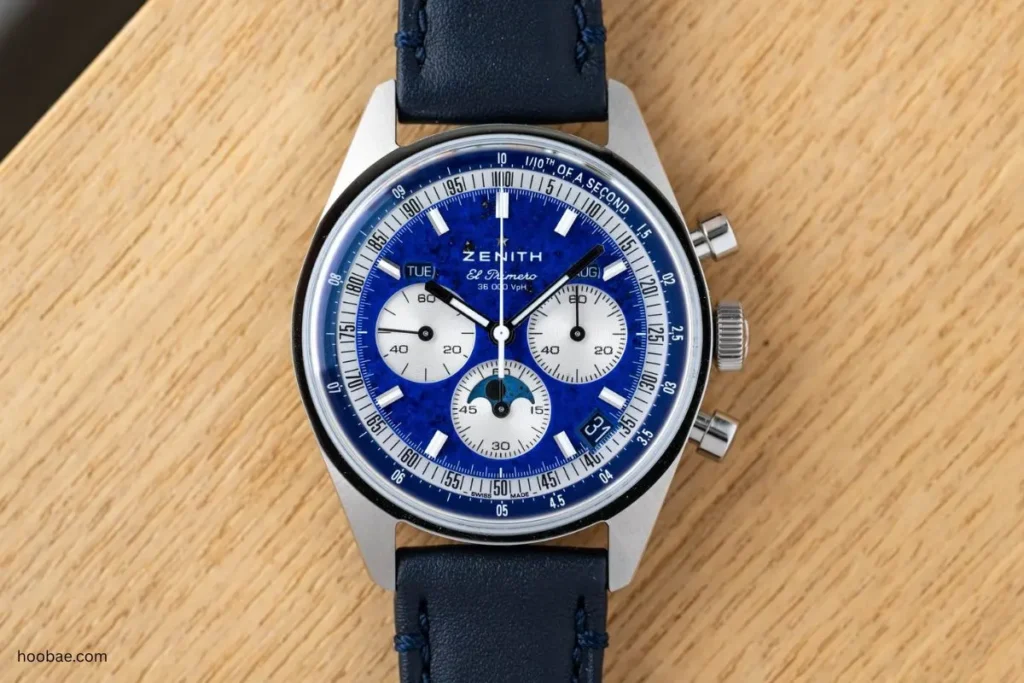It’s rare to see a new chronograph featuring a stone dial. While brands like Rolex, Omega, and Bulova have experimented with meteorites, few are truly exploring the vast range of colors and textures that stone dials can offer, especially beyond time-only models. Zenith, however, is stepping into this unique space with bold innovation.
To commemorate Zenith’s 160th anniversary, a lapis lazuli dial has been added to the brand’s Chronomaster Original Triple Calendar (03.3400.3610/51.C910). And it’s a lovely watch. Though this is the only lapis-dialed chronograph on the market right now, the design was not created out of thin air. In 2019, Zenith commemorated the 50th anniversary of the El Primero caliber with a one-of-a-kind piece created in conjunction with Phillips and Bacs & Russo: an A386 in platinum with a lapis lazuli dial, a suitable way to mark the anniversary of one of history’s most significant chronograph movements. The watch eventually sold for CHF 250,000, with money going to charity.
In case you’re not aware, Zenith’s Chronomaster Original Triple Calendar is an accurate reproduction of the original A386 case from 1969, with a 38mm diameter, 46mm lug-to-lug, and 13mm case height. A series of 25 prototypes from the era show that Zenith was preparing an A386 triple calendar with a moon phase. Still, the simpler chronograph-only model is what ended up on the general public’s wrists. Last year, Zenith reintroduced the original prototype appearance with a trio of Chronomaster Triple Calendars, each featuring a calendar module on top of the El Primero Caliber 3610. Later that year, we collaborated with Zenith on our limited edition watch, which featured a monochrome black face with meteorite subdials.
Anyway, I digress. This new lapis dial reverses the execution of a stone dial chronograph, which we saw in the meteorite edition. This means a lot more stone on the dial, with the main dial plate carved from a piece of lapis lazuli and the subdials made from conventional snailed metallic discs. From a distance, the dial is a gorgeously saturated shade of blue. Still, up close, the mineral inclusions within the stone, in varied colors of black, silver, and gold, give it a dynamic aspect that immediately reminds us of why stone dials are so enjoyable. As expected, each slice of the stone dial will be unique, resulting in distinct inclusions and overall appearance on each watch.
The triple calendar’s windows are softly cut, with a date window at 4:30 and discs for the day of the week, month, and date color-matched in dark blue to blend in. While the day of the week and month cuts are relatively small on a busy dial, they are easily readable due to the great contrast of the white lettering. The moon phase cutout is nicely integrated into the chronograph minutes subdial, with the polished moon and stars sitting on top of a boldly brushed blue disc. Because this is a triple/complete calendar rather than an annual calendar, the date/day of the week must be altered five times per year: in February, April, June, September, and November.
On the wrist, the watch feels precisely like the rest of the Triple Calendar collection. And, in my experience with the meteorite edition, the case is really worth trying on in person. A 38mm diameter is often relatively compact, yet this case wears differently than any other 38mm watch I’ve owned. From the top down, it appears normal, and the 46mm lug-to-lug distance makes sense. But from the side, you can see how high the lugs are above the case, with the case back projecting noticeably and the lugs not completely downturned at the ends. It’s not unpleasant. However, those searching for a 38mm watch that fits their wrist should try it on first.
The lapis lazuli Chronomaster Original Triple Calendar is available with a dark blue strap or a steel bracelet. The watch wears much better on the strap. It’s a combination of improved contrast and a more pleasant wearing experience (the bracelet seems somewhat lacking, bordering on disappointing, particularly the clasp). But, happily, the Chronomaster Original Triple Calendar is a strap monster, and I can only imagine the several straps that would look great with this rich blue dial.
Now for the final question: how much more would you pay for a lapis dial? The new Chronomaster Original Triple Calendar Lapis Lazuli is priced at $22,700, a considerable $8,800 more than the ordinary Chronomaster Original Triple Calendar, which costs $13,900. That is one of the most significant rises I’ve seen for a stone dial, mainly because the difference between a meteorite dial and a standard dial on a Rolex Daytona with an Oysterflex bracelet is almost $4,500.
Sure, a close-up of the Chronomaster reveals a thick cut of the stone, but this watch now sits firmly in a new price class at more than $20,000.00. There is something to be said about this watch’s unusual market positioning as a 1/10th of a second chronograph with a lapis lazuli face, triple calendar, and moon phase. If it checks off every single characteristic you look for in a watch, it’s a stunning chronograph to wear on your wrist.
You can read luxury watch news here!

